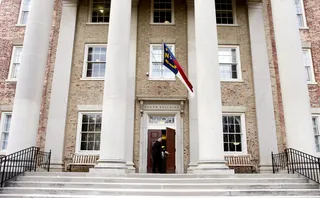How American Students Affected the Anti-Apartheid Movement
Howard, Spelman and other schools voiced their opinions.

1 / 13
Mandela’s Impact on American Student Anti-Apartheid Movement - Following the death of Nelson Mandela, President Obama said he was inspired by the late leader to protest while studying at Occidental College. “My very first political action, the first thing I ever did that involved an issue or a policy or politics, was a protest against apartheid,” said Obama. BET.com takes a look at college campuses that were active in the anti-apartheid movement in the 1980s. – Natelege Whaley(Photo: UPI Photo/Landov)

2 / 13
Occidental College - Barack Obama made his first public speech on Feb. 18, 1981, at Occidental College. He opened a rally protesting the college’s investments in South African businesses. Before he could end his speech, two students pretending to be oppressive Afrikaaners carried him off stage. (Photo: Patrick Fallon/Bloomberg via Getty Images)

3 / 13
Michigan State University - Michigan State University students and community members of East Lansing, Michigan, formed the South African Liberation Committee in 1972, one of the first organizations in the country to lead a campaign against the apartheid movement. Because of the group’s efforts, the city became the first in the U.S. to pass a resolution that ended support of businesses that operated in South Africa.(Photo: MSU.edu)

4 / 13
Spelman Gives South Africans a Voice - Spelman College launched its campaign against apartheid in 1978 and was the beginning of a seven-year protest of their school’s investment in South Africa. The students interviewed South African students in their school newspaper and hosted them on their campus to speak, in order to bring more awareness to their cause. Despite not having a large endowment, the university board chose to divest in April 1986. (Photo: Spelman College)

5 / 13
Howard, Georgetown Formed DC SCAR - The D.C. Student Coalition Against Apartheid and Racism, formed in 1983, was made up of student organizers from Howard University, Georgetown University, George Washington University, Johns Hopkins University, and the University of Maryland at College Park. The group successfully pushed for universities to divest in corporations that were in business with South Africa.(Photo: Howard.edu)
ADVERTISEMENT

6 / 13
UC Davis, UC Santa Barbara and UC Berkeley “Day of Action” - In April 1985, during a “day of action” at University of California at Davis, Santa Barbara and Berkeley, more than 300 people were arrested across the campuses while participating in the boycott of American support of South Africa’s apartheid laws. The students called for UC to divest $1.7 billion in American companies tied to South Africa.(Photo: David McNew/Getty Images)

7 / 13
Morehouse Anti-Apartheid Rally Brings Out Civil Rights Leaders - In 1985, Andrew Young, Julian Bond and John Lewis and family members of Martin Luther King Jr. and Bishop Desmond Tutu went before 2,000 students and spoke on the ties between the civil rights and the anti-apartheid movement. The leaders urged more student involvement in the fight. (Photo: Courtesy of Morehouse College)

8 / 13
Columbia Students Block Off Building for Weeks - For three weeks in April 1985, about 150 anti-apartheid student protesters blocked an entrance of a building on campus with chains and padlocks and demanded that the university remove all investments in South Africa. After a court order, students were forced from occupying the space. Columbia did not fully divest until 1991. (Photo: Mario Tama/Getty Images)

9 / 13
Fisk and Tennessee State Organizes Rally - Fisk University and Tennessee State were joined by Vanderbilt University students to rally at the state Legislative Plaza and called for the end of state divestment on Oct. 10, 1985. A Fisk student leader, who is named Ms. Taylor in a document, was one of many students who spoke before the United Nations who held a hearing on South Africa on Sept. 11, 1987. (Photo: Courtesy of Fisk University)

10 / 13
Harvard Students Build Shantytown on Campus - Harvard students built a shantytown in the middle of the campus yard to get their administration’s attention in April 1986 on the issue of anti-apartheid. Several students slept in the settlement and some classes were held there. Despite opposition, the university eventually divested half of its business connections in South Africa by spring 1987. (Photo: Jacob Russell via Wikimedia Commons)
ADVERTISEMENT

11 / 13
UNC Chapel Hill Students Push for Full Divestment - Anti-apartheid demonstrators at the University of North Carolina Chapel Hill refused to accept the board’s partial divestment in South Africa. On April 1986, the group built a shantytown on campus and vowed to live there until the school completely divested. The shanties were ordered to be taken down, but in October 1987, the school cut all investments in South African businesses. (Photo: Shawn Rocco/Landov/Raleigh News & Observer/MCT)
Photo By Shawn Rocco/Landov/Raleigh News & Observer/MCT

12 / 13
Penn State Organizers Demand Ties Cut from South Africa - On March 27, 1987, 300 Penn State University student organizers called for the resignation of the university president from the Carnegie Mellon Bank board, because of the bank’s ties to South Africa. Besides demanding the university’s full divestment from South Africa, the group was able to convince local businesses in Pittsburgh, Pennsylvania, to close their accounts with Mellon.(Photo: Rob Carr/Getty Images)
